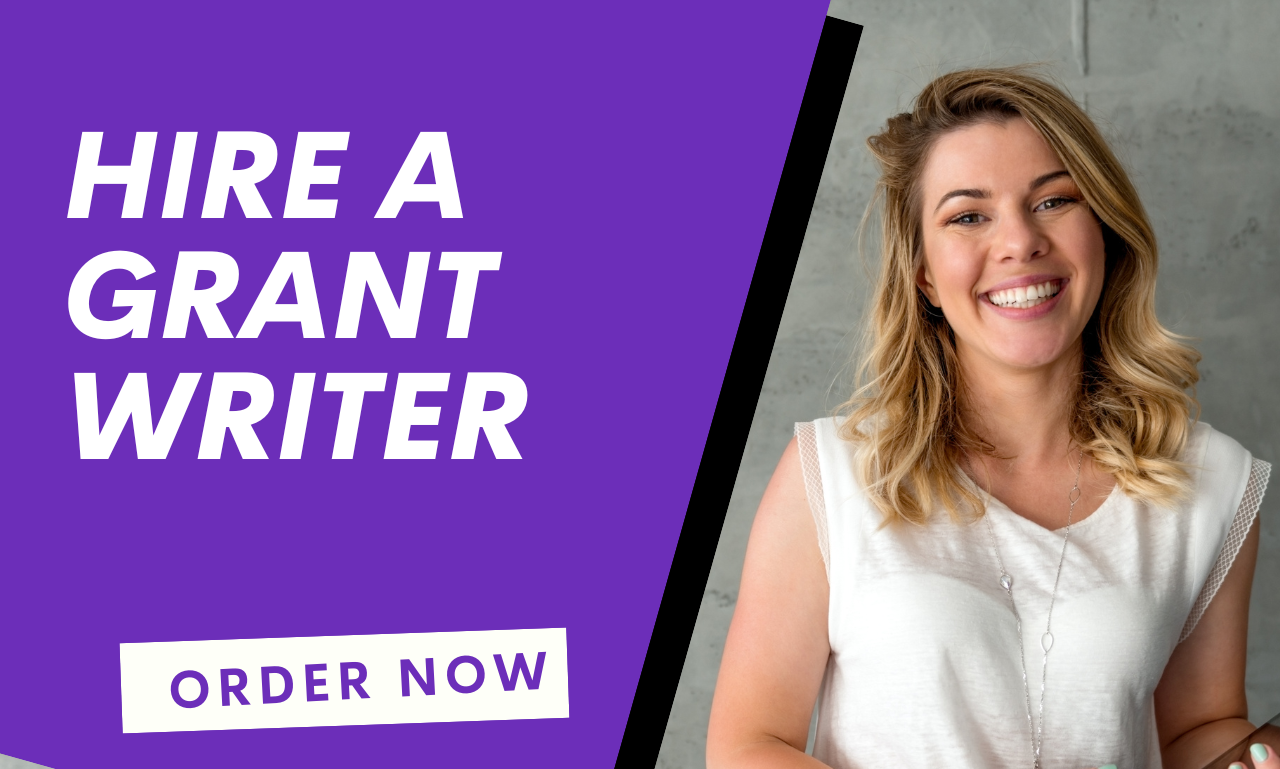Federal Grant Writing By Best Grant Writers
Federal grant writing involves preparing strong applications to request funding from government agencies. These grants support programs in areas such as education, healthcare, community development, and research.
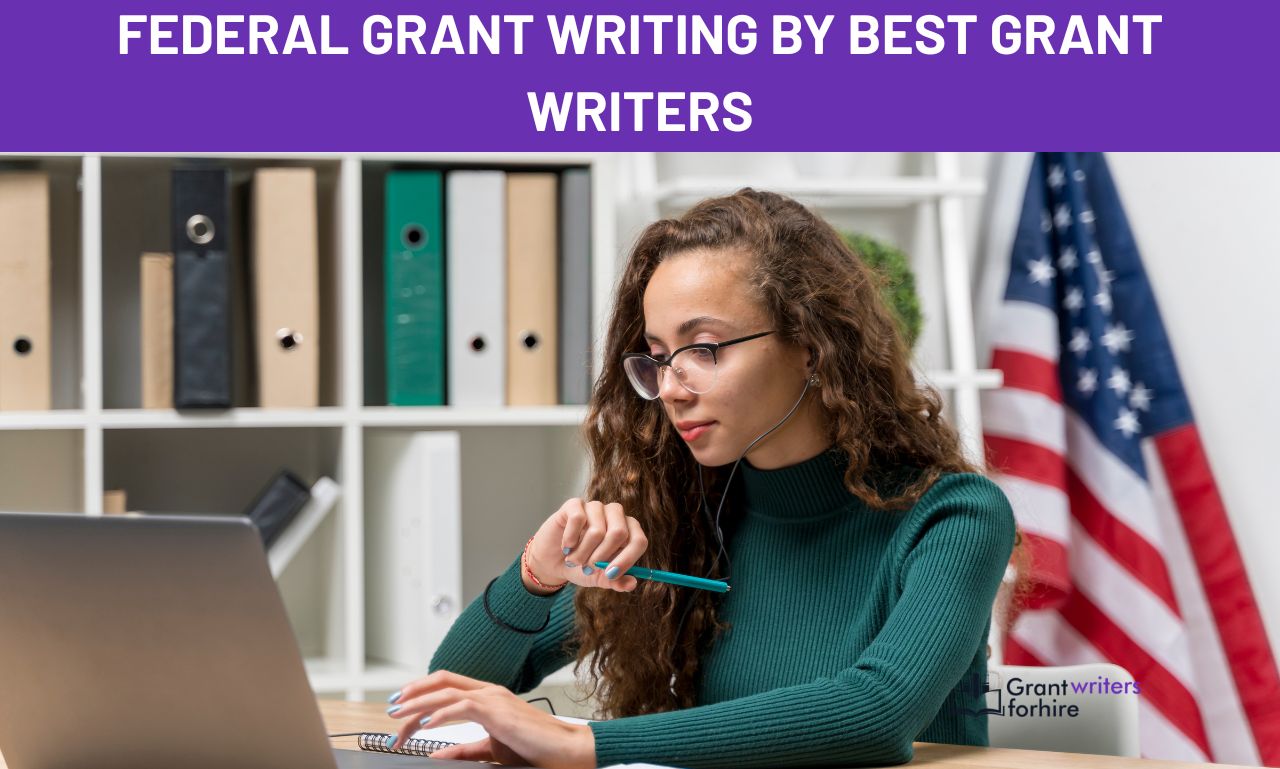
The best grant writers understand how to follow strict guidelines and present ideas in a clear, organized manner.
They use data, goals, and outcomes to show why a project matters and how it will succeed. With experience and attention to detail, they help applicants avoid common mistakes and meet deadlines. Hiring a skilled federal grant writer can improve the chances of receiving funding and ensure the proposal meets all requirements.
What Is Federal Grant Writing?
Federal grant writing is the process of asking the government for money to support a project or program. It involves writing a detailed plan that explains what the project is, why it is needed, and how the money will be used.
The writing must follow government rules and include important facts, goals, and a clear budget. This type of writing helps show that the project will make a positive impact. It is often used by schools, hospitals, nonprofits, and research groups. A good federal grant application is clear, well organized, and follows the exact format the agency asks for.
Difference Between Federal and Private Grant Writing
Federal and private grant writing are similar, but they have key differences. Federal grants come from government agencies and have strict rules and long applications while on the other hand, private grants come from companies or foundations and are usually more flexible.
Federal grants often need more paperwork, while private grants may focus more on the story or mission. Reviewers for federal grants look for results and data, while private funders may also care about passion and values. Knowing these differences helps writers prepare the right kind of proposal for each one.
Overview of Federal Grant Programs
Federal grant programs are designed to support many types of needs in the country. These can include healthcare, education, science, the environment, housing, and more. Each program has its own goals, rules, and deadlines. Some programs give money to schools or cities, while others support research or help people in need.
The programs are run by different government departments like the Department of Education or Health and Human Services. Understanding these programs is important when deciding where to apply.
Who Offers Federal Grants?
Federal grants are offered by many U.S. government agencies. These include departments like the Department of Agriculture, the Department of Energy, and the National Institutes of Health. Each agency gives grants based on its mission and focus area. For example, the Department of Education gives grants to help schools, while the Department of Health helps with public health projects. The grants are listed on the government website Grants.gov. Anyone applying must follow the rules given by the agency offering the grant.
Types of Federal Grants Available
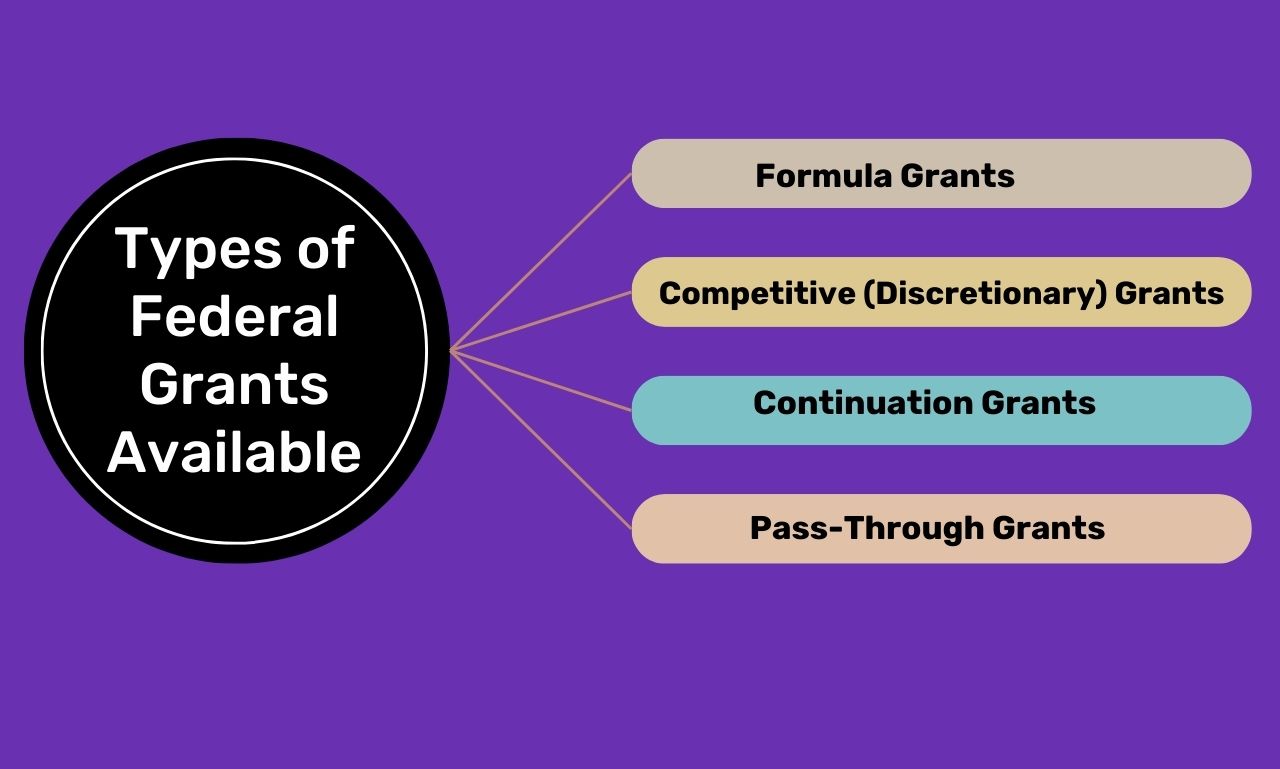
There are different types of federal grants that help support projects and programs across the country. Each type of grant has its own purpose and way of giving out money. Some are based on a set formula, while others are awarded through a competition. Knowing the types of grants helps people choose the right one for their needs. Below are four common types of federal grants;
Formula Grants
Formula grants are given to states, cities, or other organizations based on specific rules set by the government. The amount of money each group gets depends on factors like population size, poverty levels, or other public data.
These grants do not require competition, if the group meets the set conditions, they receive the money. Common uses include education programs, public health services, and transportation projects. Examples include the Title I education grants and Medicaid funding. These grants are useful for steady, long-term support.
Competitive (Discretionary) Grants
Competitive grants are also called discretionary grants because they are awarded based on the decision of a review panel. Organizations must apply and show that their project is strong, meets the grant’s goals, and uses the funds wisely. The process is highly competitive, and only the best proposals are selected.
These grants are often used in research, innovation, health services, and education improvement. An example is the National Institutes of Health (NIH) research grants. Writing a strong proposal with clear goals, a budget, and expected results is important for winning a competitive grant.
Continuation Grants
Continuation grants give ongoing support to projects that were previously funded. These grants allow the project to continue without starting a new application from scratch. However, the group must still show progress, meet the program goals, and explain why they need more funding.
This type of grant is often seen in long-term research or multi-year education programs. Agencies may review the project’s outcomes before agreeing to continue funding. Continuation grants help successful programs grow and finish their planned work.
Pass-Through Grants
Pass-through grants start with the federal government but are handed down to state or local governments. These governments then give the money to local schools, nonprofits, or other groups. Each state may have its own rules for applying and reporting.
Pass-through grants are useful for reaching smaller or local projects that may not apply directly to the federal level. For example, the federal government may give education funds to a state, which then offers grants to schools or school districts. This process helps distribute funds more widely across communities.
Who Can Apply for Federal Grants?
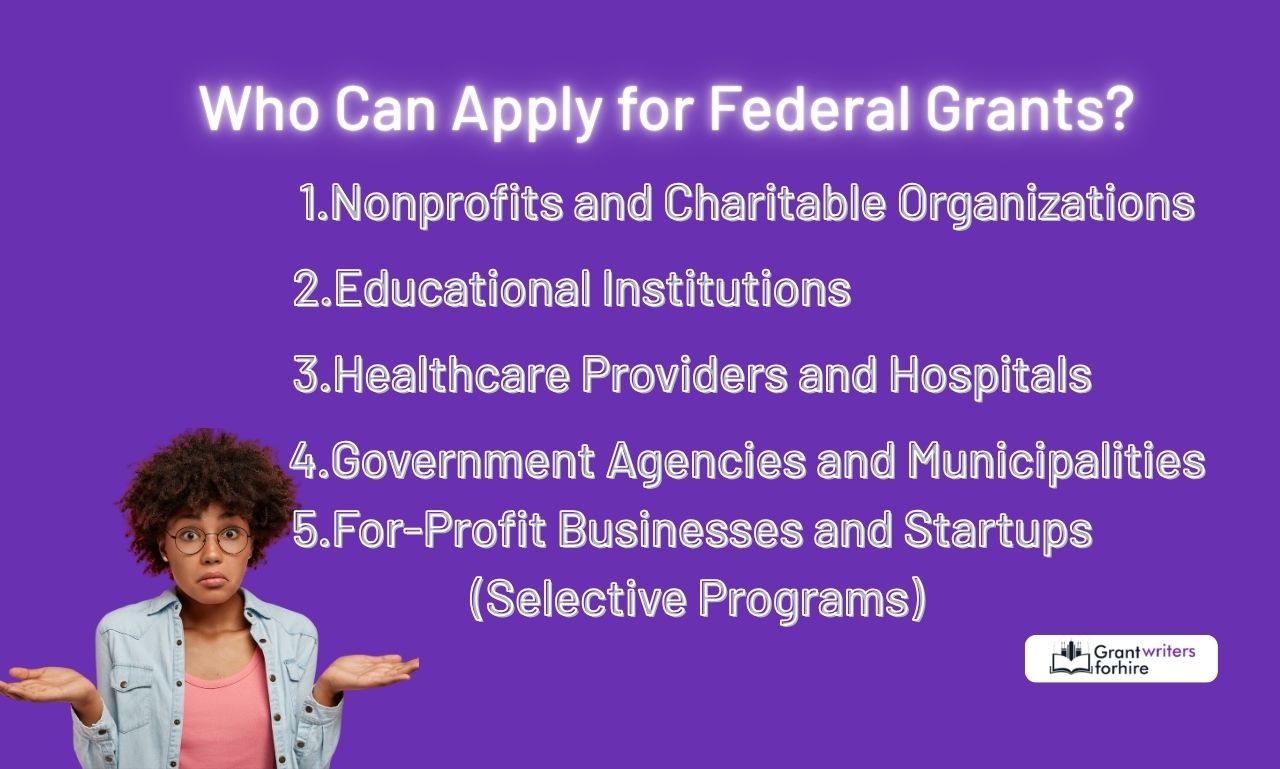
Federal grants are open to many types of groups that want to help their communities or work on important projects. These groups must follow the rules of each grant program and show how they will use the money to reach clear goals. The government supports work in areas like education, health, safety, and business. Knowing which group you belong to and what grants you qualify for is the first step in a successful application. Below are some of the main groups that can apply for federal grants:
1.Nonprofits and Charitable Organizations
Nonprofit organizations play a big role in community services. They often apply for federal grants to support housing, food programs, youth services, job training, and more. Most grants require nonprofits to be registered under IRS 501(c)(3) (Internal Revenue Status), meaning tax-exempt charitable organization.
These organizations must show that their programs benefit the public and that they have the ability to manage the money responsibly. Examples of grants they may receive include those from the Department of Housing and Urban Development (HUD) or the Department of Health and Human Services (HHS).
2.Educational Institutions
Public and private schools, colleges, and universities can receive grants to support a wide range of programs. These may include teacher development, classroom technology, special education, school safety, or research.
For example, the U.S. Department of Education provides many grants through programs like Title I and the TRIO program. Higher education institutions may also apply for research funding from the National Science Foundation (NSF) or the National Institutes of Health (NIH). These grants help improve learning and make education more accessible to all students.
3.Healthcare Providers and Hospitals
Hospitals, community health centers, and other medical facilities often qualify for federal grants. These grants can support services for low-income populations, new equipment, mental health programs, and staff training. For example, the Health Resources and Services Administration (HRSA) offers grants to improve access to healthcare in rural and underserved areas. Healthcare organizations may also apply for grants to respond to public health emergencies or develop new treatment programs.
4.Government Agencies and Municipalities
Local, state, and tribal governments often apply for grants to improve their infrastructure and public services. They may receive funding to support roads, bridges, emergency response, clean water systems, community development, or energy efficiency programs.
Agencies like the U.S. Department of Transportation, the Environmental Protection Agency (EPA), and FEMA give out these grants. Municipalities use these funds to improve safety, meet environmental goals, and serve their residents better.
5.For-Profit Businesses and Startups (Selective Programs)
While most federal grants are for nonprofits and public institutions, there are selective programs for private businesses. These include the Small Business Innovation Research (SBIR) and Small Business Technology Transfer (STTR) programs.
These are very helpful grants for companies to develop new technologies, bring products to market, and support economic growth. Grants for for-profit groups are competitive and usually focus on research, science, or energy innovation. Businesses must show they have a strong idea and the team to carry it out.
Step-by-Step Process of Writing a Federal Grant Proposal
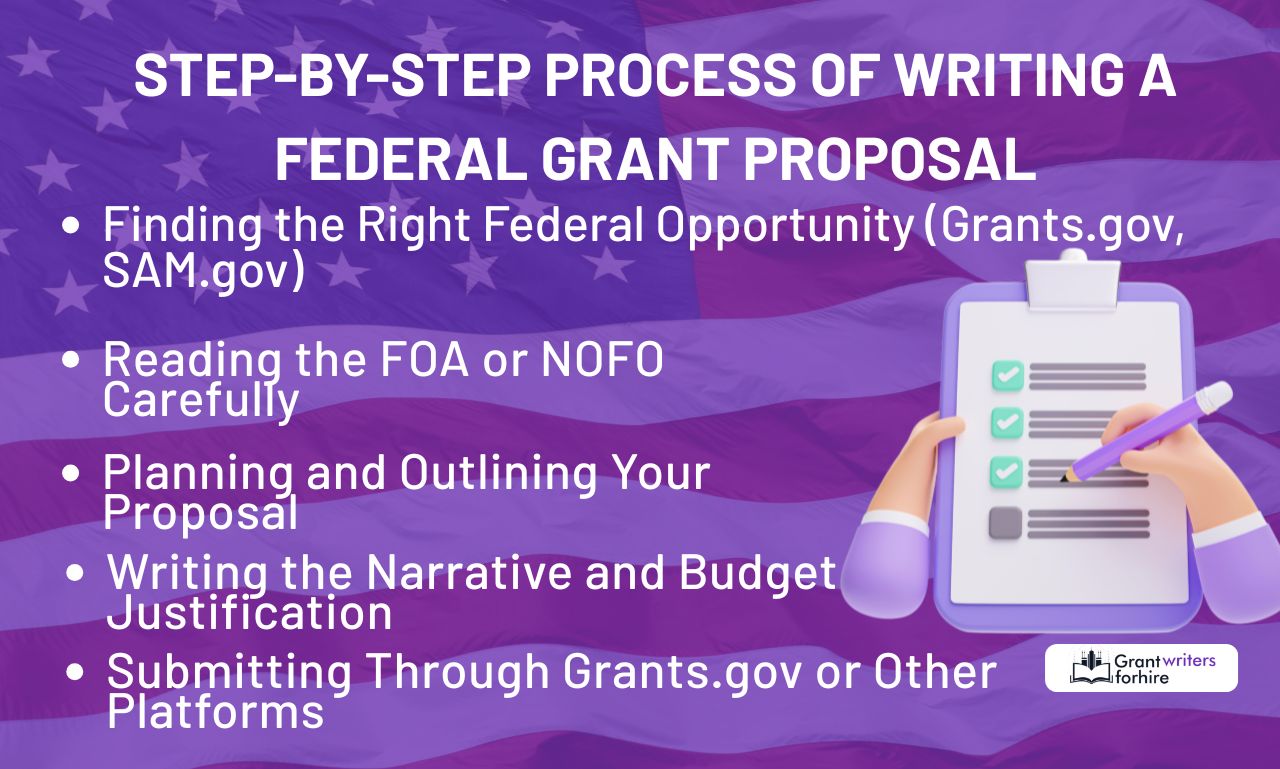
Writing a federal grant proposal takes time, planning, and close attention to detail. Each step matters because federal agencies have strict rules and high expectations.
Grant writers must follow the directions closely and include everything the agency asks for. Missing even one step can lead to a rejected application. The goal is to show that the project is needed, possible, and worth funding. Below are the main steps to follow when writing a federal grant proposal:
Finding the Right Federal Opportunity (Grants.gov, SAM.gov)
The first step is to search for suitable grants on official sites like Grants.gov or SAM.gov. These platforms list current funding opportunities from different federal agencies. You can filter results by category, agency, or eligibility. Once you find a match, register your organization and get a Unique Entity ID (UEI) through SAM.gov.
Registration is required before submitting any application. Make sure to check the deadline and funding limits. Not all grants are open to everyone, so it is important to confirm eligibility. This step helps you avoid wasting time on grants you can not apply for.
Reading the FOA or NOFO Carefully
After finding a grant opportunity, the next step is to read the FOA (Funding Opportunity Announcement) or NOFO (Notice of Funding Opportunity) carefully. This document explains everything the agency expects from applicants. It includes who is eligible, the goals of the program, the required documents, and how proposals will be reviewed. Reading it closely helps you avoid mistakes like missing a form or skipping an important section.
It also gives details about how the proposal should be formatted and submitted. Highlight key instructions and deadlines as you read. Understanding the FOA or NOFO fully is the foundation for a strong application.
Planning and Outlining Your Proposal
Before writing, take time to plan your proposal. Think about what problem your project solves, who will benefit, and how success will be measured. Create a clear outline that matches the sections listed in the FOA or NOFO. This may include an introduction, goals, methods, evaluation, and budget.
Planning saves time later and helps you stay organized. It also allows you to collect needed data or team input early. A good outline ensures your proposal stays focused and meets all requirements.
Writing the Narrative and Budget Justification
This is the main part of your proposal. The narrative tells your project’s story, what you plan to do, why it matters, and how you will do it. Use clear, simple language and include facts and goals. Avoid big words and keep your sentences short.
The budget justification explains how much money you need and how it will be spent. Be honest and provide reasons for every cost. Make sure your budget fits with your narrative and supports your goals. This section shows that your project is realistic and that you are ready to manage the funds.
Submitting Through Grants.gov or Other Platforms
Once your proposal is complete, you must submit it through Grants.gov or another platform listed in the FOA or NOFO. Upload all documents in the correct file format, usually PDF. Double-check that all sections are complete and signed, if needed.
Submit your application early to avoid last-minute errors or internet issues. After submission, you will receive a confirmation email or tracking number. Keep this for your records. Submitting on time and following all steps shows the agency that you are responsible and ready to handle the grant.
Key Elements of a Federal Grant Proposal
.
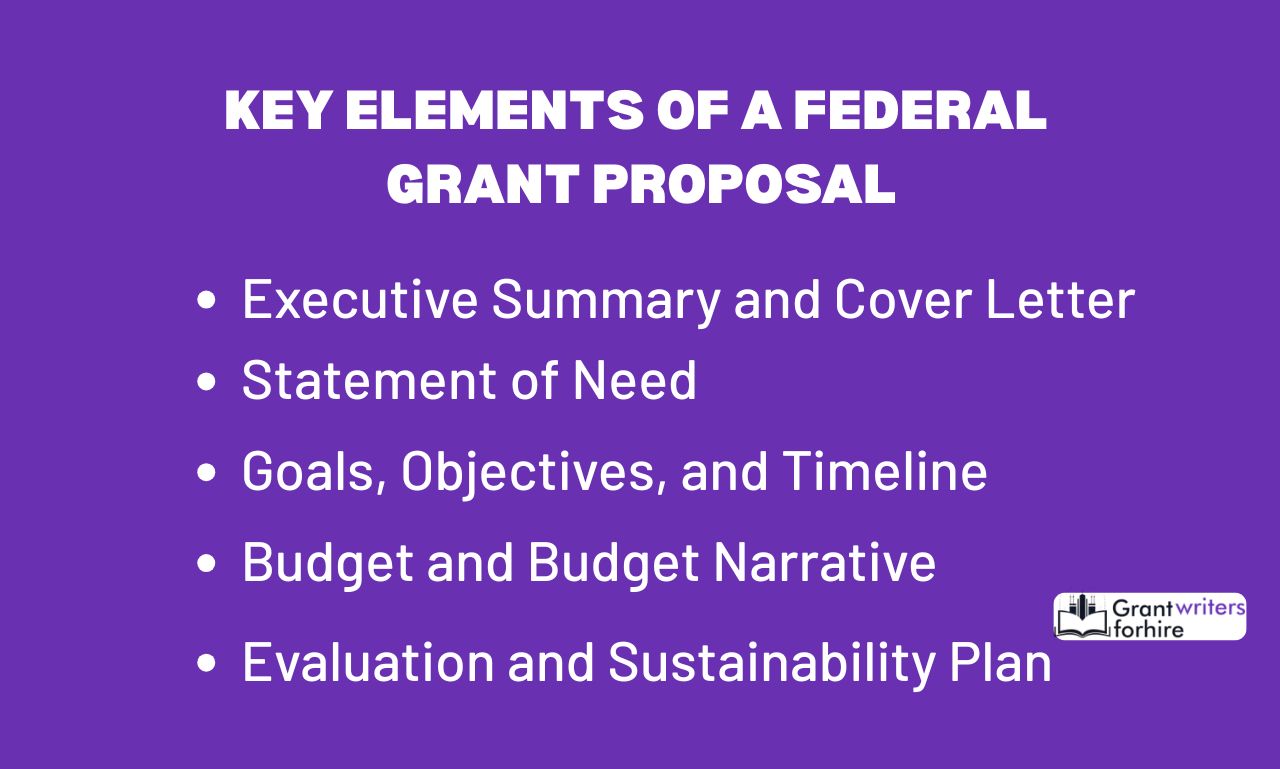
A strong federal grant proposal includes several key parts that help reviewers understand your project. Each part has a specific purpose and must follow the rules in the funding instructions. These sections work together to explain what your project will do, why it is important, and how the money will be used. Writing these sections clearly and completely can increase your chance of getting approved. These elements are as discussed below:
Executive Summary and Cover Letter
The executive summary is a short but complete overview of your proposal. It tells the funder what the problem is, what your project will do, how much money you need, and what results you expect. This is often the first thing reviewers read, so it should be strong and clear. It must summarize the full plan without repeating all the details.
The cover letter is a short, polite message to introduce your organization and express your interest in the grant. It includes your organization’s name, the grant name, contact information, and a quick note about your readiness to complete the project.
Statement of Need
The statement of need explains why your project is important. You should describe the problem your community or group is facing and back it up with facts, data, or short examples. It is important to show that the problem is real and affects a large number of people. Use sources like government reports, surveys, or research studies to support your point.
This section should also show why existing solutions are not enough. A clear and honest need statement helps reviewers understand why funding your project is necessary.
Goals, Objectives, and Timeline
This part shows what you want to achieve and how you will do it. Goals are the big, overall outcomes, like “Improve student reading scores.” Objectives are smaller steps that lead to the goal, such as “Train 20 teachers in new reading strategies.” Each objective should be specific, measurable, and time-based.
A timeline breaks these steps into months or weeks to show when each task will happen. This helps reviewers see that your project is realistic and organized. It also shows that your team knows how to stay on schedule.
Budget and Budget Narrative
The budget lists all the costs your project will have, such as salaries, materials, travel, equipment, and other expenses. Each item must include an amount and be reasonable based on your plan. The budget narrative explains why each cost is needed and how it connects to your project activities. For example, if you ask for money for training, explain who will be trained, for how long, and by whom. This section must match the timeline and project description. A good budget shows that your project is affordable and that the money will be used wisely.
Evaluation and Sustainability Plan
The evaluation plan explains how you will measure the success of your project. It could include surveys, interviews, tests, or progress reports. You should also say who will collect the data and how often it will be done. This shows the funder that you care about results and improvement.
The sustainability plan describes how you will keep the project running after the grant ends. This could include using local support, other funding, or community partnerships. Funders want to know that their investment will continue to help people even after their money is used.
Common Mistakes to Avoid in Federal Grant Writing
When writing a federal grant proposal, small errors can lead to big problems. Many good projects are rejected because the proposal is unclear, missing parts, or did not follow the instructions. To improve your chances, it is important to understand and avoid the most common mistakes. Paying attention to the details and writing each section properly helps your proposal stand out in a positive way. The most common mistakes include:
Ignoring Formatting or FOA Instructions
Every grant has specific instructions in the FOA (Funding Opportunity Announcement). If you do not follow these rules,like page limits, font size, file format, or required sections then your proposal may be rejected without review. Always read the FOA more than once and make a checklist before you start.
Weak Needs Assessment or Data
If your proposal does not clearly show why the project is needed, reviewers may not take it seriously. A strong needs section uses facts, numbers, and real examples to prove the problem exists. Avoid general statements or opinions with no support.
Incomplete or Vague Budgets
Your budget should list all costs clearly and explain why each cost is needed. If items are missing or unclear, it may seem like you are not prepared. A strong budget matches your project plan and shows you will spend the money wisely.
Overpromising Outcomes
It is good to aim high, but do not promise results that are not realistic. If you say you will solve a big problem quickly with little money, reviewers may doubt your plan. Set clear, reachable goals and explain how you will measure success.
Best Practices for Writing Successful Federal Grants
Writing a successful federal grant takes more than just filling out forms. It requires planning, teamwork, and a clear message that matches what the funder wants. Following proven methods can help improve your chances of getting approved. Below are some best practices to guide you through the process.
-
Align with Funder Goals and Mission
Before writing, make sure your project matches the goals and mission of the funding agency. Read their website, past grant awards, and the FOA to understand what they care about. Use words and phrases that reflect their focus areas.
If your proposal does not clearly fit their goals, it will likely be rejected. Show how your project supports their mission and solves a problem they want to fix. Funders want to invest in projects that match their purpose. This shows that you have done your homework and respect their priorities.
-
Use Clear, Simple, and Impactful Language
Good writing is easy to understand. Use short sentences and everyday words to explain your project. Avoid hard words or long paragraphs that confuse the reader.
Make your points clear and strong by using facts, examples, and expected results. If the reviewers can understand your idea quickly, they are more likely to support it. Focus on the impact your project will have and explain why it matters. Clear writing builds trust and shows that your team can manage the project well.
-
Collaborate with Team Members and Stakeholders
Federal grant writing is a group effort. Talk to team members, partners, and community groups early in the process. Each person may have useful ideas, data, or support to add to the proposal.
Working together helps make the plan stronger and more complete. It also shows funders that the project has support from others. Team input can help avoid mistakes and improve the final draft. Make sure roles and responsibilities are clear to keep things on track.
-
Start Early and Build in Time for Review
Start writing your proposal as soon as you find a good funding opportunity. Federal grants often need many documents, letters, and approvals, which take time to gather. Waiting until the last minute can lead to errors and missed deadlines.
Plan time for reviewing, editing, and checking all parts of the application. Ask someone else to read it and give feedback. Starting early helps reduce stress and improves the quality of your proposal. Review time is just as important as writing time.
Tools and Resources for Federal Grant Writers
Having the right tools can make federal grant writing easier and more successful. These resources help with finding grants, planning proposals, and making sure everything follows the rules. Using trusted tools saves time and helps avoid mistakes. Below are some helpful tools and resources every federal grant writer should know:
Top Federal Grant Databases (Grants.gov, Catalog of Federal Domestic Assistance)
Grants.gov is the main website where you can search and apply for federal grants. It lists opportunities from all U.S. government agencies. You can search by keyword, category, or agency to find the right grant.
The Catalog of Federal Domestic Assistance (now part of SAM.gov) gives detailed descriptions of federal programs. It helps you understand what each grant supports and who can apply. These sites are free to use and updated often. They are the best place to start your grant search.
Proposal Writing Templates and Samples
Templates and samples are helpful for planning your proposal. They give you a clear format to follow and show what a strong application looks like. You can find samples online from universities, nonprofits, and government sites. These examples can guide you on what to write in each section.
Templates also help keep your writing organized and make sure you do not miss any parts. Use them as a guide but always write in your own words. A good format makes your proposal easier to read and understand.
Budget Calculation Tools
Budget tools help you list project costs clearly and correctly. They often come as spreadsheets or online calculators that include common cost categories. These tools reduce errors and help you stay within the limits set by the grant.
They can also help show if your budget matches your goals. Some tools include formulas that auto-calculate totals and check for mistakes. A good budget tool saves time and improves accuracy. Reviewers expect a clear and honest budget.
Federal Register and SAM.gov Updates
The Federal Register is where the government posts new funding rules, grant announcements, and deadlines. Reading it helps you stay informed about changes that may affect your application. SAM.gov is where you register your organization and get a Unique Entity ID, which is needed to apply for grants.
It also gives updates about agency programs and alerts. Checking these sources often helps you stay ahead of deadlines and new funding chances. Being updated means you will not miss out on any important grant opportunities.
Do You Need a Federal Grant Writer?
Federal grant writing can be a long and detailed process. Some organizations choose to write proposals on their own, while others get help from a professional. Hiring a grant writer can improve the chances of success, especially for first-time applicants or large projects. It is important to know when help is needed, what kind of writer to choose, and how much it may cost.
When to Hire a Professional Writer
You may want to hire a grant writer if your team is too busy, lacks experience, or has tried and failed before. A professional can save time and help avoid mistakes in formatting, budgeting, or planning. This is helpful when applying for big federal grants that have strict rules.
A grant writer also knows how to present your ideas clearly and match the agency’s goals. If the project is important and the funding is large, investing in expert help may be a smart choice. Hiring someone early in the process gives better results. Always check the writer’s past work before you decide.
Freelance vs. Agency Writers
Freelancers work alone and often cost less than agencies. They may be a good fit for small projects or short deadlines. Agencies usually have a team of experts, so they can handle large or complex proposals. Some agencies also offer editing, research, and full proposal planning.
Freelancers may be more flexible, while agencies may offer more services and structure. The best choice depends on your budget, timeline, and project needs. Always ask for samples and check reviews before choosing either one.
Costs and ROI of Hiring Help
Hiring a grant writer costs money, but it can be a good investment. Freelancers may charge by the hour or by project, while agencies often use flat rates. Prices can range from a few hundred to several thousand dollars, depending on the work. While this may seem high, getting a grant can bring in tens or hundreds of thousands in funding.
A well written proposal can pay off the cost many times over. If your chances of success improve with expert help, the return is often worth it. Just be sure the writer gives clear terms and a timeline before starting.
Federal Grant Writing FAQs
How Long Does It Take to Write a Federal Grant?
Writing a federal grant can take several weeks to a few months. The time depends on how long the proposal is, how much information is needed, and how prepared your team is. Some grants require many sections like goals, budget, and evaluation plans.
You also need time to collect letters, reports, and approvals. It is best to start early and plan ahead to avoid rushing. A simple mistake from rushing can lead to rejection. Give yourself at least 4 to 6 weeks to complete everything on time
What Is the Success Rate of Federal Grant Applications?
Federal grant programs are very competitive. Success rates vary depending on the agency and type of grant. Some programs fund 10% to 30% of applicants, while others may fund fewer.
The success rate also depends on how well your proposal matches the funder’s goals. A strong, clear proposal has a better chance. Following all instructions and showing real impact can help you stand out. Even if you do not win the first time, you can learn and apply again.
Are Federal Grants Taxable?
Most federal grants given to businesses or individuals are considered taxable income. If the grant helps cover costs like salaries or rent, that money may be taxed. Nonprofits and government groups usually do not pay taxes on grants used for public benefit.
It is important to talk to a tax expert or accountant to know how the rules apply to you. Always keep good records of how the grant money is used. Some agencies may ask for reports or receipts. Understanding tax rules helps you plan better.
Can One Grant Proposal Be Used for Multiple Applications?
You can use parts of a proposal more than once, but not the full application. Each grant has different goals, formats, and instructions. Copying one proposal to send to another agency without changes is risky. Reviewers may notice and reject it. Instead, take the main ideas and adjust them to fit the new grant’s needs. Make sure each proposal matches the specific rules and goals of the program. Customizing your proposal shows respect for the agency and improves your chance of success.

